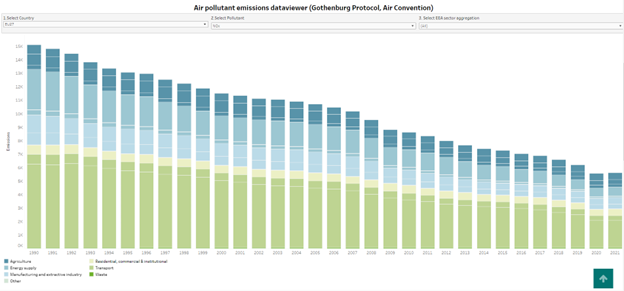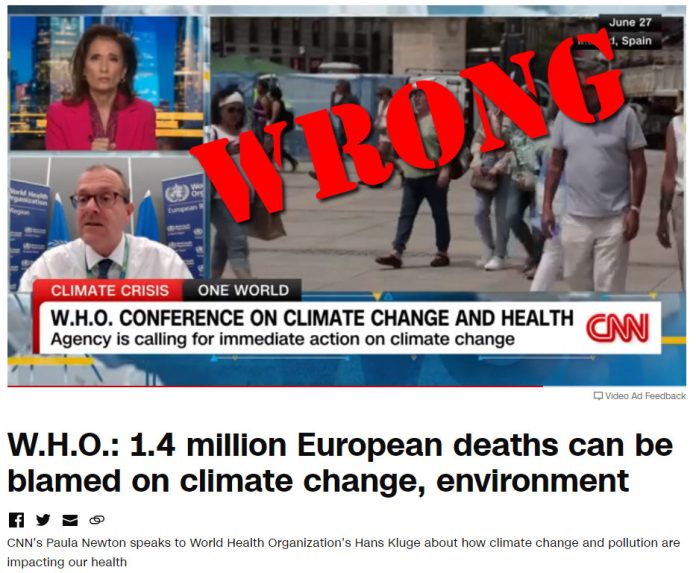A recent video news story on CNN claims that climate related deaths in Europe are 1.4 million per year. This is false. Climate change occurs on timescales longer than one year and unless a long-term trend is evident directly showing a causal connection between changes and deaths, one can’t attribute any percentage of the deaths in any one year to climate change. Further, data shows that deaths related to severe weather events and temperature related deaths both have declined significantly over recent decades globally, pollution is also trending down.
CNN interview is titled “W.H.O.: 1.4 million European deaths can be blamed on climate change, environment” features a conversation with the World Health Organization’s (WHO) Hans Kluge.
Kluge blames 1.4 million deaths per year in Europe directly on climate change and other environmental factors. He cites no data or evidence to back up his claim, because the data that exists refutes it. The interview not coincidentally coincides with The WHO conference during which the agency is calling for immediate action on climate change to prevent climate related deaths.
It is important to realize that climate change acts on long time scales. As described on Climate at a Glance: Weather vs. Climate, the World Meteorological Organization defines 30 years as the minimum for any climate related data. For deaths to be blamed on climate change one would have to see a consistent trend in deaths corresponding to changes in climate. There is no such trend. Severe weather events and sometimes extreme temperatures (more often cold than hot), experienced around the world on a day-to-day basis, can result in deaths, but those trends have declined steeply during the recent period of modest warming. Climate change can’t be causing more deaths when deaths related to weather are declining.
The Intergovernmental Panel on Climate Change (IPCC) AR6 report, Chapter 11, Weather and Climate Extreme Events in a Changing Climate, provides conclusions, summarized in Figure 1, illustrating the fact that severe weather events cannot be detected as increasing nor attributed to human caused climate change:

No evidence exists that any specific weather event is directly driven or worsening by so-called man-made climate change from increased carbon dioxide in Earth’s atmosphere. Even the IPCC’s summary of the state of global climate science makes no such attribution.
Indeed, human mortality attributable to weather related disasters, including floods, droughts, storms, wildfires, and extreme temperatures has declined by more than 99 percent over the last 100 years. In the 1920s, death related to weather-related disasters averaged approximately 485,000 each year. By 2020 the average number of deaths attributable to extreme weather events had fallen 7,790. See Figure 2, below.

In addition to severe weather events, mortality can also be attributed to extremes of temperature. Climate change is often cited as being the reason for increasing temperatures and therefore increased heat related deaths. But the opposite is actually true. This was confirmed by a study in the prestigious medical journal The Lancet in 2021. The study reports that the number of deaths associated with cold temperatures decreased by more than double the amount that deaths tied to hotter temperatures increased over the 20-year period of the study. But, as seen in figure 3 below the number of deaths in Europe due to cold outnumber the number of deaths due to heat by a factor of three to one.

In part as a result the decline in cold temperatures, over the period of the study, temperature-related mortality has declined significantly, with a total of 166,000 fewer deaths tied to non-optimal temperatures.
This study confirms what research previously published in The Lancet, the Southern Medical Journal, and the Centers for Disease Control, and National Health Statistics Reports has consistently shown that cold is the biggest temperature related killer, not heat.
This contrary data flies in the face of the claims made on CNN by the WHO official Kluge.
But there’s more. In addition to blaming climate, WHO blames air pollution in Europe as a cause of death in the interview. But the data doesn’t even support that claim. Examining real world air pollution data from the European Environmental Agency, seen in Figure 4 below, show a sharp downtrend since 1990 on all types of air pollution in the 27 country European Union.

As with climate change, air pollution can’t be causing an increase in the number of deaths in Europe now than in the past because there is less pollution.
The bottom line is the claim that climate change is causing millions of Europeans to die each year as CNN and the WHO maintain is not supported in real world data no matter how you look at it. This is a clear-cut case of climate activism trumping truthful reporting and CNN should be ashamed to publish this interview.
If the WHO really wanted to cut 1.4 million excess deaths, instead of calling for action on climate change, they could call on the world to follow their own far more rational and practical advice in their report: “Improving access to water, sanitation and hygiene can save 1.4 million lives per year, says new WHO report.”

















Where are the vaunted “fakecheckers” when you need them?
Clearly, info from the World Hype Organization cannot be taken at face value.
Apparently, WHO has learned that “governing disinformation” is easier if it is the source.
“climate”, the go-to for libs when something they did causes harm